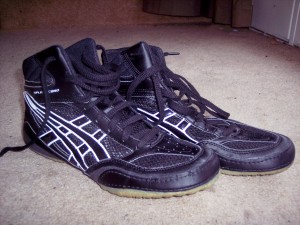What kind of shoes are these and what’s the seven-year story behind them?
*
Picture a little boy, four years old, with wavy, light brown hair and captivating hazel eyes, who cannot talk. He tries to play with other children by bumping into them and laughing. He doesn’t know how to play, but he tries. He sees children laughing and playing together as a group, so in his mind, he thinks they are bumping into each other, and he believes that this is the way to play. The other children don’t understand. They think that he is being mean, that he is pushing them and laughing at them. All he wants is to join in. And he craves physical contact to meet his proprioceptive needs.
Picture the same little boy, now in second grade. He is talking, although he still exhibits echolalia and mixes up pronouns and word order. This, along with his sensory issues and behavioral challenges, makes it rather difficult to have friends, but he still tries, usually by initiating physical contact. One day, while on a class field trip (accompanied by his one-on-one aide) to the local high school, he visits the Wrestling Room. He is entranced. Though not able to verbalize it yet, he consciously vows that he will attend this high school and be on the wrestling team.
Now picture that same boy at age fifteen. His darker brown hair has developed more pronounced curls, and his eyes are still as captivating. He has learned, through social skills classes and personal experience, that physical contact is best reserved for roughhousing with friends that he’s known for a long time. Then the day comes, two months into his freshman year, when he signs up for the wrestling team. He comes home from school and tells his mother, using perfect sentence structure, that he needs to get a physical done as soon as possible so that he will be allowed to “get on the mats” at practice. He reminds her of how he’s waited seven years to be on the high school wrestling team, and she tells him that she remembers. She remembers that day so long ago when she picked him up from school and his aide told her about the field trip and how much he loved the Wrestling Room. She remembers the various elementary school Christmas Programs that were held at the high school over the years and how, even though her son couldn’t be in the program because of his sensory issues, they would walk by the Wrestling Room and he would tell her “That’s what I am going to do when I go to this high school.” And his mother, not sure if he could ever comprehend the rules of a sport and actually be on a team, but wanting to be supportive, would say in a positive tone, “We’ll see!”
They get the physical done, they buy the wrestling shoes, and the son starts diligently attending practice every day after school. They go to the Parent Night, and the mother approaches the coach at the end of the meeting to introduce herself. She is already impressed by the fact that, during the meeting, when her son asked a question that was a bit self-explanatory, the coach had answered him with genuine respect and patience. So she goes up later and shakes his hand and asks if he is familiar with her son’s IEP for his autism. And the coach assures her that, yes, he has spoken with her son’s case manager and is aware of his challenges. Then he tells her with such sincerity how well her son is doing. And the mother fights a lump in her throat as she tells the coach, “He’s been wanting to do this for a long time,” and thanks him, very much.
Now picture the little boy’s mother picking him up from wrestling practice the next evening. She pulls into the parking lot and sees his lean frame striding toward the car, wrestling shoes in hand. It strikes her that her son is on a sports team for the first time ever. And now she is picking him up from practice, just like all the other parents do with their sons. She sees a huge smile on her son’s face as he nears the car. The lump returns and her eyes sparkle with tears. He has followed his dream and achieved his goal. He is on the high school wrestling team, and he loves it.
He gets in the car and excitedly tells his mother about the techniques he is learning and how he’s already pinned two people at practice! The mother, hoping that the darkness is hiding her watery eyes, tells him how proud she is of him. She asks him if wrestling is everything he thought it would be. “Well,” he says, “I didn’t know we would have to learn tactics. But I like learning by doing.” She asks him what his favorite part is about wrestling. “That I get to meet new friends. And they understand me.” The mother, hoping that her voice isn’t shaking too much, tells him how great that is. And how glad she is to hear it. All those years ago, he knew exactly what he needed.


Pingback: As If | Tanya Savko